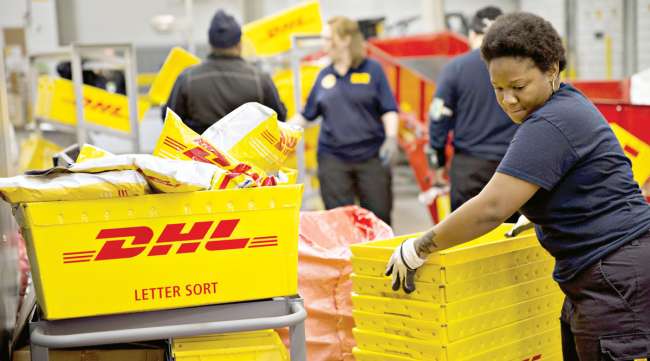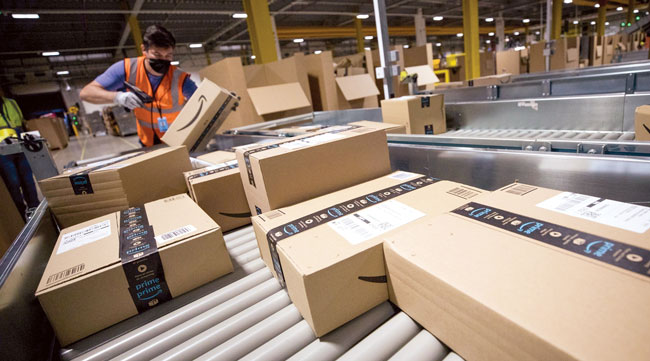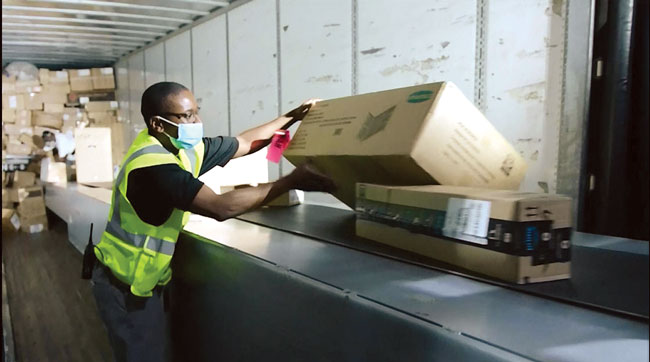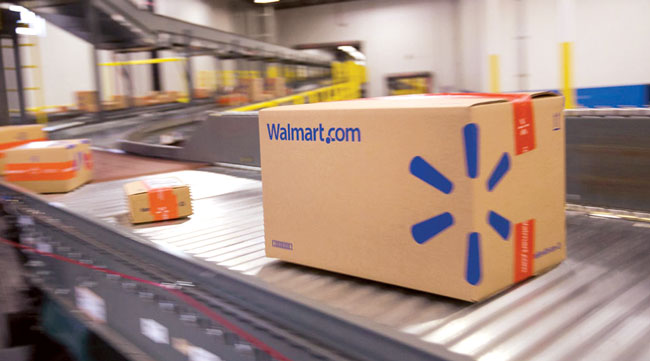Contributing Writer
How Logistics Firms Are Handling the Pandemic's E-Commerce Boom

[Ensure you have all the info you need in these unprecedented times. Subscribe now.]
The COVID-19 pandemic has squeezed many years of growth in online sales and e-commerce fulfillment into a single 12-month period.
Confronted with business closures, restrictions on large gatherings, physical distancing guidelines and the fear of catching the novel coronavirus, consumers turned their computers and phones into shopping malls, spending $861 billion online with U.S. merchants in 2020, a 44% increase over the prior year, according to estimates by Digital Commerce 360.
In fact, e-commerce accounted for more than 21% of total retail sales last year, up from less than 16% in 2019, the research firm reported. That increase of more than five percentage points far eclipsed previous annual gains in online shopping.
“People are bored sitting at home and have extra money that would have been spent on a vacation,” said Cathy Morrow Roberson, an industry consultant who heads Logistics Trends & Insights.
They are spending that money on their homes, including buying exercise equipment and office furniture and equipment for remote work, and they are doing much of that spending online, Roberson said.
►A Fresh Look at the Top 50
►Map: Where the Top 50 Are
►Armstrong: COVID-19 Upends Market
►Lineage Logistics Makes Rail Bet
►Drones Could Help Move Vaccines
Sector Rankings
Freight Brokerage | Dedicated
Dry Storage Warehousing
Refrigerated Warehousing
Ocean Freight | Airfreight
“What was expected to happen in seven years happened in one year last year,” said Kraig Foreman, president of eCommerce at DHL Supply Chain Americas.
Westerville, Ohio-based DHL Supply Chain ranks No. 7 on the Transport Topics Top 50 list of the largest third-party logistics companies in North America. The contract logistics provider is a business unit of Germany-based Deutsche Post DHL Group.
It wasn’t an easy transition as retailers and logistics providers had to adapt to dramatic changes in the marketplace quickly, said Sean Henry, CEO and co-founder of Stord, an Atlanta-based supply-chain visibility and e-commerce fulfillment company.
First, companies had to reorganize their operations to implement social distancing and other health safety protocols.
“Our operations were not built for social distance,” Foreman said. “Before the pandemic you tried to get as much done in as little space as possible because optimizing space is efficient.”
And then they had to deal with massive supply chain disruptions as entire economies slid into limp mode in the initial months of the pandemic while the virus spread. Depending on the business, the fulfillment centers had to help clients deal with massive demand as shoppers flocked to stores or started ordering online.
Other logistics companies had clients that were forced to close as lockdowns set in and now wanted to develop e-commerce capability quickly.
At the same time, some companies found their ability to restock hampered by lengthy delays at the nation’s largest ports, a result of the massive amount of inventory coming to U.S. shores.
Along the way, they also had to adjust to the general increase in e-commerce demand.

Wilson
“The volume increase we are seeing means that we have to work differently than in the past. Manual operations can’t keep up with the activity,” said Malcolm Wilson, slated to become CEO of a new global contract logistics company, GXO Logistics, following its planned spinoff from XPO Logistics later this year. He currently heads XPO’s European operations.
XPO’s split into two separate companies is expected to close in the second half of 2021. XPO will retain its less-than-truckload and freight brokerage business while its logistics segment becomes GXO.
Greenwich, Conn.-based XPO ranks No. 2 on the TT Top 50 list of logistics companies prior to the planned spinoff.
Another complicating factor is that the rapid growth in the volume of goods is mirrored by an increasing number of discrete items — including furniture and appliances — being shipped, Wilson said.
“We have to work even harder to make our warehouses more efficient,” he said. “Consumers don’t want to wait weeks or even days for their product to arrive. Organizations like XPO have to be able to shorten lead times against a bigger volume of orders.”
Logistics and e-commerce fulfillment executives said the pandemic demonstrated how companies need to rapidly build capabilities to deal with the changing business environment.
Agility is at the top of the list.

Foreman
“People behaving a certain way this afternoon immediately hits the fulfillment supply chain,” DHL’s Foreman said.
But agility is not just about making an adjustment at the drop of a hat, Stord’s Henry said. It’s also about making intelligent changes based on data, and understanding where products need to be for customers.
Through it all, companies also have been expanding their reverse logistics operations.
“The number of returns coming back has grown significantly with e-commerce, but it is complex taking that stuff back,” said Greg West, C.H. Robinson Worldwide’s vice president of less-than-truckload and head of its consolidation centers.
C.H. Robinson, based in Eden Prairie, Minn., ranks No. 1 on the TT Top 50 logistics companies list.

While Amazon does not appear on the Top 50 Logistics list, it is a massive player in the e-commerce space. (Chris Ratcliffe/Bloomberg News)
For returns, companies have to consider the value of the product and the cost of taking it back. Much of it gets liquidated, West said. Depending on the item, many retailers simply tell the consumer to keep it and credit them for the cost.
As they adjusted to changing demand and supply chain configurations, many companies found themselves constrained by their logistics partners’ capacity and technology limits, such as their order management systems.
“If you’re a shipper and all of a sudden you can’t get your goods to market, it’s a big wake-up call,” West said.
That’s why companies such as C.H. Robinson and Stord are investing in both capacity and technology that can help clients deal with sudden bottlenecks.
C.H. Robinson acquired Prime Distribution Services from Roadrunner Transportation Systems Inc. for $225 million in cash just as the pandemic was spreading into the United States last year. Prime offers a suite of distribution, fulfillment and inventory management services and plugged a gap in C.H. Robinson’s operations.
“You have to bring transportation and warehousing together. It’s hard to hit the requirements of large retailers if you can’t marry that business,” West said.

An employee unloads boxes at a UPS facility. UPS Supply Chain Solutions ranks No. 3 on the Top 50. (UPS)
Stord, a 5-year-old startup, wants to help retailers navigate rapidly shifting consumer shopping patterns by offering a flexible array of logistics and fulfillment services, primarily by leasing warehouse space distributed nationally. Henry said such an approach extracts brands from needing to build warehouses across the country to meet consumer expectations for rapid delivery.
“Our overall mission is to be a shipper’s cloud supply chain platform — both the physical logistics network and the software together in one platform,” Henry said.
He said much of the industry is gravitating in that direction as retailers work to get the correct amount of inventory as close to consumers as possible. The Stord system allows shippers to use data to rebalance goods nationally and increase shipping speed.
C.H. Robinson and others also are offering demand planning and forecasting tools.
Shippers are tackling the pandemic-driven boom in e-commerce with multiple strategies, XPO’s Wilson said.
“We have customers that simply want XPO to solve a problem. They will give us the data, and we will design a supply chain for them and operate a warehouse,” he said.

Packages move along a conveyor belt inside a Walmart fulfillment center in Pennsylvania. (Michael Nagle/Bloomberg News)
But others want to outsource warehousing because they don’t want to distract from their core businesses, Wilson said.
Regardless of the approach, the use of technology — both hardware and software — is helping the industry cope with the e-commerce surge.
“You are seeing a lot of retailers embracing cloud technology so that they can know where their inventory is in real time,” said Roberson, of Logistics Trends & Insights.
That enables them to better position inventory and connects the middle mile with the last mile in delivery service.
The past holiday season demonstrated why that capability is essential, Roberson said. It speeds delivery to shoppers and gives them accurate tracking information, which eases consumer concerns.
Automated hardware adoption also is accelerating.
XPO, for one, has been deploying automation and robotics in its warehouses to boost productivity.
But that creates a challenge for XPO — to design warehouses that meld both human labor and automation. Robots can’t yet gift wrap a package or take over all goods-picking operations to fulfill an order, Wilson said.
All of the effort the logistics industry is making now to deal with the e-commerce surge will pay off for years to come, executives said.
“A lot of people won’t go back to how they used to shop,” Wilson said. “They will be quite happy shopping online and not leaving their homes.”
Want more news? Listen to today's daily briefing below or go here for more info:


